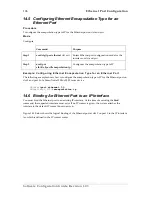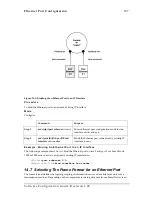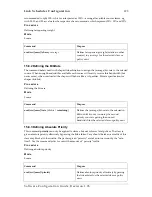
Link Scheduler Configuration
119
•
it is a clean way of combining different
decision criteria
and
•
it can also be a nice way to cope with groups of traffic classes
In Figure 15-3 an example of hierarchical scheduling is illustrated. The 1
st
level arbiter
Level_1
uses
weighted fair queuing to share the bandwidth among source classes VPN, Web and incorporates the
traffic from the 2
nd
level arbiter
Low_Priority
, which itself uses shaping to share the bandwidth
among source classes Mail and Default.
Software Configuration Guide, Revision 1.03
Figure 15-3: Example of Hierarchical Scheduling
Parts of the configuration used for arbiter
Level_1
are listed below. Take account of the line rate-limit
on the top which is responsible for limiting the overall output o 512 kBit/s. The arbitration uses
weighted fair queuing to share the bandwidth among the two classes VPN and Web and the policy
Low_Priority. The source class local-voice has absolute priority and is therefore effectively bypassing
the link arbiter, as shown in Figure 15-3. The VPN class gets at least 30%, the Web class gets at least
40%, and the Low_Priority policy gets 30% of the overall bandwidth. Moreover there is defined that
a maximum of 50 packets are queued for the source class Web.
profile service-policy Level_1
rate-limit
512
mode wfq
source class local-voice
priority
source class VPN
share 30
…
source class Web
share 40
…
source policy Low_Priority
















































